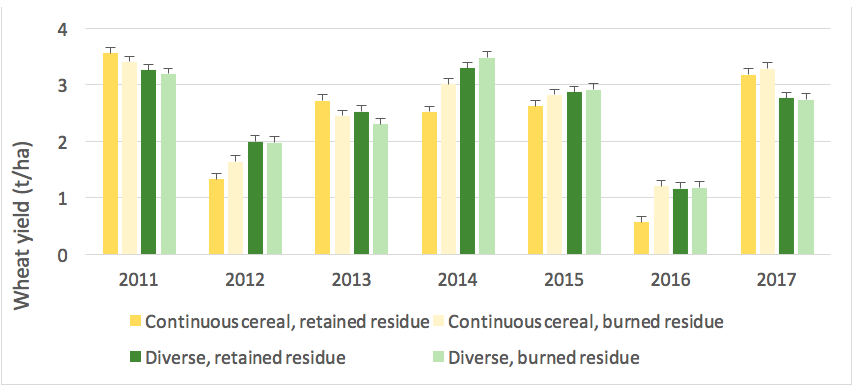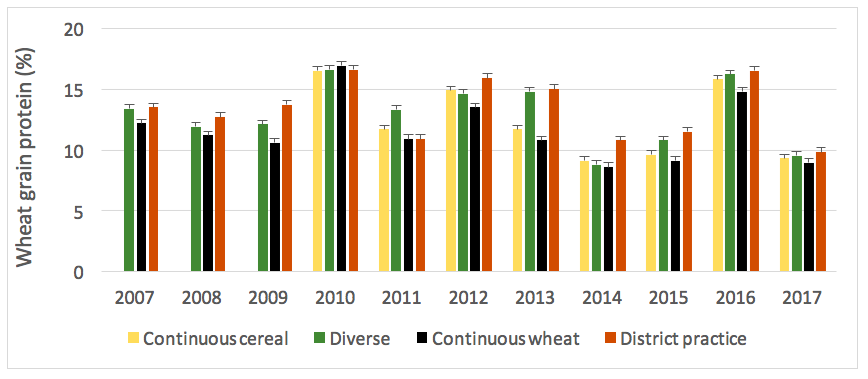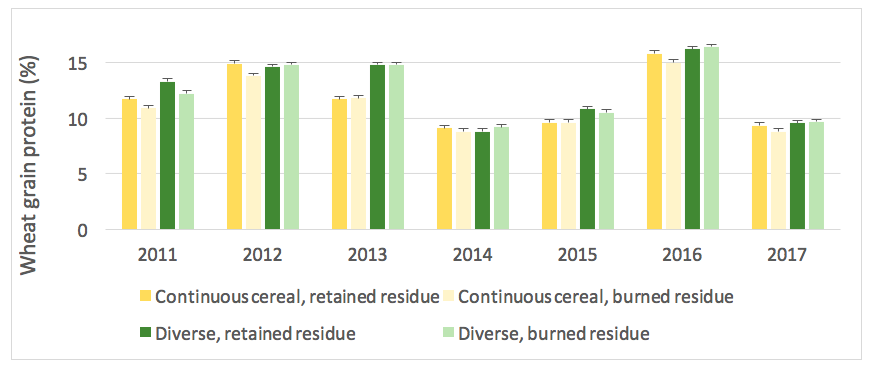Long-term rotation diversity, but not residue handling, affects wheat yield and protein content.
Author: Phil Ward, Ken Flower, David Minkey, Shayne Micin, Neil Cordingley, CSIRO, University of Western Australia, WANTFA | Date: 26 Feb 2019
Key Messages
- Wheat in the most diverse rotation is now consistently producing more grain (by about 0.2t/ha), with consistently higher grain protein (by about 1.6%), compared with the continuous wheat treatment.
- Residue windrowing and burning has reduced residue levels by about 50%, which has had an inconsistent impact on crop yield and has decreased wheat protein in the cereal rotation, but not in the diverse rotation.
Aims
The long-term rotation trial at Cunderdin was originally established in 2007 to develop and test enhanced conservation farming practices, built around minimum soil disturbance, maximum residue retention, and diverse rotations. In this report we show the impacts of rotation diversity and residue handling on wheat yield and protein content.
Method
Trial design and location
The trial was set up in a randomised block split-plot design with three replicates, in a paddock on the Cunderdin Agricultural College on a red loamy soil. Each main plot (based on rotation – see next sub-section) is 36m by 80m.
Rotations and N application
Four rotations are being compared in the main plots of the trial: continuous wheat (one plot); continuous cereal (three plots, e.g. wheat/wheat/barley); ‘district practice’ (three plots e.g. wheat/wheat/chemical fallow); and diverse (three plots, e.g. wheat/legume/canola) (Table 1). Therefore there are 10 main plots per replicate. The trial commenced in 2007, and has just completed its 4th full three-year rotation (2007-09; 2010-12; 2013-15; 2016-18). The wheat variety was Bonnie Rock (2007-09), Magenta (2010-12), Mace (2013-15) and Impress (2016-18).
Table 1. Crop rotations at the long-term trial, and average quantity of N applied (kg N/ha/yr) for each rotation.
Sequence | 1 | 2 | 3 | 4 | 5 | 6 | 7 | 9 | 10 | 11 |
|---|---|---|---|---|---|---|---|---|---|---|
Year | Continuous cereal | Diverse | Wheat | District practice | ||||||
2007 | Saia | Barley | Barley | Wheat | Vetch | Canola | Wheat | Wheat | Barley | Lupin |
2008 | Barley | Barley | Saia | Vetch | Canola | Wheat | Wheat | Barley | Lupin | Wheat |
2009 | Barley | Saia | Barley | Canola | Wheat | Vetch | Wheat | Lupin | Wheat | Barley |
2010 | Wheat | Wheat | Wheat | Wheat | Pea | Canola | Wheat | Wheat | Barley | Pea |
2011 | Wheat | Wheat | Wheat | Pea | Canola | Wheat | Wheat | Barley | Pea | Wheat |
2012 | Wheat | Wheat | Wheat | Canola | Wheat | Pea | Wheat | Pea | Wheat | Barley |
2013 | Wheat | Wheat | Barley | Wheat | Ch.pea | Canola | Wheat | Wheat | Barley | Fallow |
2014 | Wheat | Barley | Wheat | Ch.pea | Canola | Wheat | Wheat | Barley | Fallow | Wheat |
2015 | Barley | Wheat | Wheat | Canola | Wheat | Ch.pea | Wheat | Fallow | Wheat | Barley |
2016 | Wheat | Wheat | Barley | Wheat | Albus | Canola | Wheat | Wheat | Barley | Fallow |
2017 | Wheat | Barley | Wheat | Albus | Canola | Wheat | Wheat | Barley | Fallow | Wheat |
2018 | Barley | Wheat | Wheat | Canola | Wheat | Albus | Wheat | Fallow | Wheat | Barley |
N applied | 50.1 | 51.3 | 50.1 | 32.1 | 33.4 | 32.7 | 53.7 | 31.2 | 30.5 | 31.8 |
Nitrogen was applied to each crop based on anticipated N requirement and yield depending on seasonal conditions. No extra N was applied to legumes or fallows.
Residue handling
In the continuous cereal and diverse rotations, the main plots were split into sub-plots (18 m by 80 m) commencing with the 2010 harvest. Sub-plot treatments were residue retained and spread behind the header; or residue windrowed and burned before sowing the next crop.
Results and Discussion
Wheat yield
Wheat yield has varied considerably from year to year, and differences between the rotations were small and non-significant for 2007-2009 (average 2.3 t/ha) (Figure 1). For the period 2010-2017, average wheat yield in the higher residue treatments was greatest in the district practice treatment (2.49 t/ha), where wheat has been grown after a fallow since 2013. In the diverse treatment, average wheat yield (2.25 t/ha) was significantly (LSD = 0.12) greater than from the continuous cereal treatment and the continuous wheat treatment (both 2.07 t/ha).

Figure 1. Wheat yield in various higher residue rotations since 2007. Error bars represent the least significant difference (LSD) for comparing treatments.
There was no consistent effect of residue management on crop yield. In some years (e.g. 2011 and 2013), residue retention was associated with increased crop yield, but in other years (e.g. 2014), residue burning gave higher yields (Figure 2).
 Figure 2. Wheat yield as affected by residue retention and rotation. Error bars represent the least significant difference (LSD) for comparing treatments.
Figure 2. Wheat yield as affected by residue retention and rotation. Error bars represent the least significant difference (LSD) for comparing treatments.
Grain protein
Wheat protein content varied considerably from year to year (Figure 3). It was generally highest in the district practice treatment (grown after the fallow since 2013), and was nearly always higher in the diverse treatment than in the continuous wheat treatment (Figure 3). For the period 2011 -2017, average grain protein was 12.9% in the district practice, 12.6% in the diverse, 11.7% in the continuous cereal, and 11.0% in the continuous wheat treatments (LSD = 0.3). The higher grain protein in the diverse rotation is associated with the inclusion of the legume in the rotation, and the assumed N fixation in the legume crop. There may also be benefits from enhanced N cycling associated with the diverse rotation, but further research will be necessary to determine the magnitude of any effect. The higher grain protein in the district practice treatment in earlier years of the trial is presumably due to legumes in the rotation, and in later years is related to mineralised nitrogen accumulated in the fallows.
 Figure 3. Wheat grain protein content in various rotations since 2007. Error bars represent the least significant difference (LSD) for comparing treatments.
Figure 3. Wheat grain protein content in various rotations since 2007. Error bars represent the least significant difference (LSD) for comparing treatments.
Overall, residue retention significantly increased grain protein in the continuous cereal treatment, with average grain protein (2011 – 2017) increasing from 11.2% to 11.8% with residue retention. There was no significant effect of residue retention on average wheat grain protein in the diverse rotation (12.6% for high residue, 12.5% for low residue) (Figure 4). The retention of cereal stubble, with a generally low N content, was previously thought to tie up soil N, and was expected to lead to a decline in wheat grain protein. Therefore, the increase in grain protein with residue retention in the continuous cereal rotation was a surprising result. The greater input of fresh organic matter may have stimulated microbial activity leading to greater N mineralisation, but again, further research will be necessary to confirm this, and to determine the value of any positive impact.

Figure 4. Wheat grain protein as affected by residue retention and rotation. Error bars represent the least significant difference (LSD) for comparing treatments.
Nitrogen balance
Over the last 12 years, the frequency of cereal crops was 100% in the continuous cereal and continuous wheat rotations, 67% in the district practice rotation, and 33% in the diverse rotation. The frequency of legume crops was 0%, 0%, 17% and 33% for the respective rotations. Looking at all phases of each rotation, up to the 2018 season, N application as fertiliser to the continuous cereal, and continuous wheat rotations (50 - 54kg N/ha/yr; Table 1), was around 8kg/ha/year greater than the N exported in grain. With assumptions for rhizobial N fixation taken from Unkovich et al. (2010) for the legume crops, N input was around 10 kg/ha/year greater than exported in the diverse rotation, but the balance was very close to neutral for the district practice rotation. Given that there is no allowance in this calculation for N leaching or other losses, it seems likely that higher yields and grain protein levels in the district practice treatment are due to mineralisation and accumulation of soil N reserves during the fallow. Without adequate replacement of these reserves, the high yields and protein contents observed in the district practice treatment may not last for much longer. However, results in the diverse rotation showing higher wheat yields with higher grain protein contents appear sustainable in the long term.
Conclusion
A diverse rotation of wheat/legume/canola, over the long term, leads to increased wheat yield (by about 0.2 t/ha), and also to increased wheat grain protein content (by 0.9% to 1.6%), when compared with a continuous cereal, or a continuous wheat rotation. Preliminary estimates of the N balance of the rotations suggests that these benefits are sustainable. While the causes of the yield and protein benefit are associated with the inclusion of grain legumes in the rotation, there may also be other benefits in the associated soil N cycling that have not been quantified yet.
The district practice rotation (with legume initially and then fallow) also resulted in higher yields (by about 0.4 t/ha) and grain protein (by 1.2% and 1.9%) compared with continuous cereal and continuous wheat; however the sustainability of this is yet to be determined.
Acknowledgments
Thanks to the Cunderdin Ag College for making the land available for this research. The research undertaken as part of this project is made possible by the significant contributions of growers through both trial cooperation and GRDC investment, the author would like to thank them for their continued support.
GRDC Project Number: UWA00174
References
Unkovich, MJ, Baldock, J, Peoples, MB (2010) Prospects and problems of simple linear models for estimating symbiotic N-2 fixation by crop and pasture legumes. Plant and Soil 329, 75-89.
GRDC Project Code: UWA00174,
Was this page helpful?
YOUR FEEDBACK
